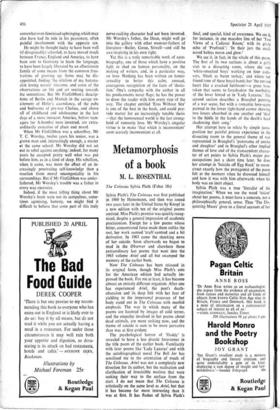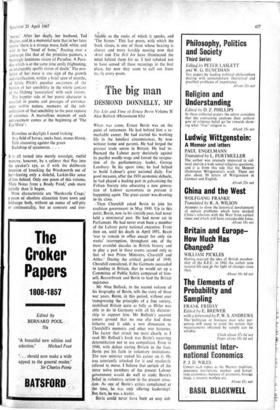Metamorphosis of a book
M. L. ROSENTHAL
The Colossus Sylvia Plath (Faber 18s) Sylvia Plath's The Colossus was first published in 1960 by Heinemann, and then was issued two years later in the United States by Knopf in a new edition with ten of the original poems omitted. Miss Plath's promise was quickly recog- nised, despite a general impression of academic precisionism. Except for a few poems whose bitter, concentrated force made them unlike the rest, her work seemed `craft'-centred and a bit derivative. In 1963 came the shocking news of her suicide. Soon afterwards we began to read in the Observer and elsewhere those extraordinary last poems that went into the 1965 volume Arid and all but swamped the memory of the earlier book.
Now The Colossus has been reissued in its original form, though Miss Plath's cuts for the American edition had actually im- proved the book. For me at least, it has become almost an entirely different organism. After one has experienced Ariel, the poet's death- obsession and its deep link with her fear of yielding to the impersonal processes of her body stand out in The Colossus with morbid emphasis. The way in which many of the poems are haunted by images of cold terror, and the empathy involved in her poems about dead animals, are more striking now, and the theme of suicide is seen to be more pervasive than was at first evident.
The psychological horror of `Daddy' is revealed to have a less drastic forerunner in the title poem of the earlier book. Familiarity with later poems like 'Lady Lazarus' and with the autobiographical novel The Bell Jar has sensitised me to the orientation of much of The Colossus. Ariel was not a completely new direction for its author, but the realisation and clarification of irresistible motives that were seeking their way to the surface from the start. I do not mean that The Colossus is artistically on the same level as Ariel, but that it has become far more interesting than it was at first It has flashes of Sylvia Plath's
final, and special, kind of awareness. We see it, for instance, in one macabre line of her 'Two Views of a Cadaver Room,' with its grisly echo of Trufrock': 'In their jars the snail- nosed babies moon and glow.'
We see it, in fact, in the whole of this poem. The first of its two sections, is about a girl's visit to a dissecting room, where she sees `white-smocked boys' working on four cada- vers, 'black as burnt turkey,' and where her friend (one of these boys) hands her `the cut-out heart like a cracked heirloom'—a gross love- token that seems to foreshadow the morbidity of the lover hinted at in `Lady Lazarus.' The second section describes a Brueghel painting of a war scene, but with a romantic love-scene painted in the lower right-hand corner showing two lovers absorbed in one another and `deaf to the fiddle in the hands of the death's head shadowing their song.'
Her attempt here to relate by simple juxta- position her painful private experience in the dissecting room to the general theme of war represented in Brueghel's `panorama of smoke and slaughter' and to Brueghel's other implied themes of love and of the transcendent charac- ter of art points to Sylvia Plath's major pre- occupations just a short time later. So does her attempt in `Suicide off Egg Rock' to recon- struct exactly how the protagonist of the poem felt at the moment when he drowned himself and how it was with him afterwards when his body was an inert object.
Sylvia Plath was a true `literalist of the imagination.' When we use the word `vision' about her poems, it must have a concrete, not a philosophically general, sense. Thus 'The Dis- quieting Muses' gives us a literal account of her `muses.' After her death, her husband, Ted Hughes, said in a memorial note that in her later poems 'there is a strange muse, bald, white, and wild in her "hood of bone," floating over a landscape, like that of the primitive painters, a burningly-luminous vision of Paradise. A Para- dise which is at the same time eerily frightening, an unalterably spotlit vision of death.' The evo- lution of her muse is one sign of the growth and clarification, within a brief span of months, of Sylvia Plath's peculiar awareness of the burden of her sensibility in the whole context of the lifelong `association' with such visions.
The happier side of her poetic character is revealed in poems and passages of entrance- ment within nature, moments of the sub- ordination of that sensibility to the pure rapture of existence. A marvellous moment of such entrancement comes at the beginning of 'The Eye-Mote': Blameless as daylight I stood looking
At a field of horses, necks bent, manes blown, Tails streaming against the green Backdrop of sycamores. . . .
It is all turned into merely nostalgic, rueful memory, however, by a splinter that flies into the speaker's eye, as if with the deliberate intention of knocking the Wordsworth out of her—leaving only a doleful, Larkin-like sense of loss behind. Only one poem of this volume, `Flute Notes from a Reedy Pond,' ends more joyfully than it began.
More characteristic are Ilardcastle Crags,' a poem of absolute alienation from town and landscape both, without an ounce of self-pity or sentimentality, but as concrete and irre-
N.btable as the rocks of which it speaks, and `The Stones.' This last poem, with which the book closes, is one of those whose bearing is clearer and more harshly moving now that A riel and The Bell Jar have illuminated the mind behind them for us. I feel rebuked not to have sensed all these meanings in the first place, for now they seem to call out from ne, rly every poem.







































 Previous page
Previous page